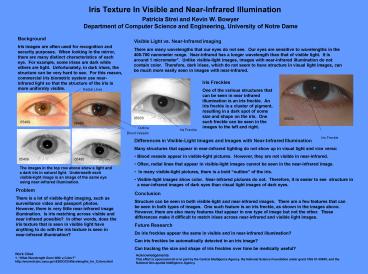Iris Texture In Visible and NearInfrared Illumination PowerPoint PPT Presentation
1 / 1
Title: Iris Texture In Visible and NearInfrared Illumination
1
Iris Texture In Visible and Near-Infrared
Illumination
Patricia Strei and Kevin W. Bowyer Department of
Computer Science and Engineering, University of
Notre Dame
Background Iris images are often used for
recognition and security purposes. When looking
in the mirror, there are many distinct
characteristics of each eye. For example, some
irises are dark while others are light.
Unfortunately, in dark irises, the structure can
be very hard to see. For this reason, commercial
iris biometric system use near- infrared light so
that the structure of the iris is more uniformly
visible.
Visible Light vs. Near-Infrared imaging There are
many wavelengths that our eyes do not see. Our
eyes are sensitive to wavelengths in the 400-700
nanometer range. Near-infrared has a longer
wavelength than that of visible light. It is
around 1 micrometer1. Unlike visible-light
images, images with near-infrared illumination do
not contain color. Therefore, dark irises, which
do not seem to have structure in visual light
images, can be much more easily seen in images
with near-infrared.
Iris Freckles One of the various structures that
can be seen in near infrared illumination is an
iris freckle. An iris freckle is a cluster of
pigment, resulting in a dark spot of some size
and shape on the iris. One such freckle can be
seen in the images to the left and right.
Radial Lines
05033
05033
05033
05409
05485
Outline
Iris Freckle
Blood Vessels
Iris Freckle
- Differences in Visible-Light Images and Images
with Near-Infrared Illumination - Many structures that appear in near-infrared
lighting do not show up in visual light and vice
versa - Blood vessels appear in visible-light pictures.
However, they are not visible in near-infrared. - Often, radial lines that appear in visible-light
images cannot be seen in the near-infrared image. - In many visible-light pictures, there is a bold
outline of the iris. - Visible-light images show color. Near-infrared
pictures do not. Therefore, it is easier to see
structure in a near-infrared images of dark eyes
than visual light images of dark eyes.
05409
05485
The images in the top row above show a light and
a dark iris in natural light. Underneath each
visible-light image is an image of the same eye
using near-infrared illumination.
Problem There is a lot of visible-light imaging,
such as surveillance video and passport photos.
However, there is very little near-infrared image
illumination. Is iris matching across visible
and near infrared possible? In other words, does
the iris texture that is seen in visible light
have anything to do with the iris texture is seen
in near-infrared illumination?
Conclusion Structure can be seen in both
visible-light and near-infrared images. There
are a few features that can be seen in both types
of images. One such feature is an iris freckle,
as shown in the images above. However, there are
also many features that appear in one type of
image but not the other. These differences make
it difficult to match irises across near-infrared
and visible light images. Future Research Do iris
freckles appear the same in visible and in
near-infrared illumination? Can iris freckles be
automatically detected in an iris image? Can
tracking the size and shape of iris freckles over
time be medically useful?
Work Cited 1. What Wavelength Goes With a
Color? http//eosweb.larc.nasa.gov/EDDOCS/Wavele
ngths_for_Colors.html
AcknowledgementsThis effort is sponsored all or
in part by the Central Intelligence Agency, the
National Science Foundation under grant CNS
01-30839, and the National Geo-spatial
Intelligence Agency.

